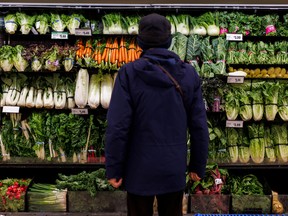The good news: almost anything that can be grown, can be grown in Canada, but it’s not always going to be easy to find — or cheap
Article content
The latest edition of the Canada Food Guide recommends that half the foods Canadians eat in a day should come in the form of fruits and vegetables. It does not, however, make any mention of where these foods should come from. But the threat of punishing trade tariffs from U.S. President Donald Trump (not to mention his continued talk of annexation) has many Canadians wondering if the produce they buy from the United States might be better sourced from closer to home.
Advertisement 2
Article content
The good news on this front is that almost anything that can be grown can (thanks to greenhouse technology and other wonders of modern science) be grown in Canada. The bad news is that some of the more exotic items (think oranges, so ubiquitous in Florida that orange juice is the state’s official beverage) are not produced on an industrial scale in this country. So while it may be possible to find them, it’s not always going to be easy — or cheap.
Demers, located in Lévis, Quebec, just south of Quebec City — its motto is “proudly Quebecois” — grows strawberries, blackberries and raspberries in fields, and tomatoes, peppers and eggplants in greenhouses. A dedicated tomato production greenhouse, built in 2011, makes harvests possible 12 months a year. The company supplies chains such as IGA, Provigo, Métro, Loblaws and Maxi in Quebec, and operates a year-round kiosk at its headquarters in Lévis.
Meanwhile, on the Ontario side of the (Quebec) border, Bamford Produce has a local-first philosophy, stating: “As soon as the local produce season starts, we purchase locally. As long as certain fruits and vegetables are growing locally, you can be guaranteed that Bamford Produce will be able to provide these produce items directly to your business.”
Article content
Advertisement 3
Article content
Recommended from Editorial
But while tomatoes and (in season) strawberries may be relatively easy to source, other more tropical items are harder to come by in Canada. Harder, but not impossible.
In North Sannich, B.C., just north of Victoria on Vancouver Island, Bob and Verna Duncan operate Fruit Trees and More, a nursery and demonstration orchard specializing in subtropical fruits. Among its offerings: apples, pears, plums, peaches, apricots, nectarines, cherries, quince, medlar, kiwis, pineapple guavas, figs, pomegranates, loquats, persimmons, olives, jujubes and avocados.
“We’ve been growing mediterranean tree fruits here for more than 30 years,” Bob Duncan told the National Post. And while they sell some fruit as well as jams and marmalades, their focus is showing others how to grow their own.
One of Duncan’s favourites is the yuzu, a citrus fruit popular in China and Japan, which is both hardy (the trees can withstand temperatures as low as -9 C) and high in value, with the fruit selling for up to $50 a pound.
Advertisement 4
Article content
Duncan grows yuzus “like apples” in the middle of his yard, but he also cultivates lemons, limes and mandarin oranges, planting the trees against south and west exterior walls where they get a little more reflected heat, and covering them with a mild heat source — “I use those old incandescent Christmas lights,” he says — on nights where the temperatures fall below freezing.
The result: a crop of 200 to 300 lemons per tree, with an energy cost of about a penny a fruit.
Just north of the Duncans’ farm, on Salt Spring Island, horticulturalist Jane Squier runs an operation known simply as The Garden. In a 6,000-square-foot greenhouse, she grows 35 varieties of cold-hardy citrus, 4 varieties of avocado, passion fruit and other subtropical fruit.
“Thermal mass, energy curtains and a wood gasifier furnace keep the greenhouse temperature above 1° C throughout the winter,” she says on her web site. “Learning how to grow healthy, nutrient dense fruit in our cold northerly climate with low energy inputs is the challenge, and sharing useful information a goal.”
Such personal operations may be (forgive the expression) small potatoes when compared against national and international markets. Still, it’s a start. A 2023 study by CAPI, the Canadian Agri-Food Policy Institute, found that Canada already produces more than half its carrots, tomatoes, squash, corn and apples domestically, with a small export market to boot.
Advertisement 5
Article content
And a Royal Bank report, “The Greenhouse Boom: How indoor farming can transform food production and exports,” notes that fruit and vegetable production in greenhouses had risen for 11 consecutive years now, up 9.2 per cent in 2023 to $2.5 billion, double what it was a decade ago.
“Canada’s greenhouse sector is a hotbed for growth,” it added, while cautioning that energy consumption and opening new markets would continue to be a drag on expansion. It also noted that bananas were “one to watch” in a list of potential growth industries that included spinach, okra, coffee and berries beyond just strawberries.
In a pinch, Canadians can also swap out one food for another. A recent article with the eye-catching title “We don’t need American fruit and vegetables” notes that while Canadian-sourced apple juice may not have the same amount of vitamin C as Florida orange juice, there are ways to make up the shortfall.
“Staying in Ontario, thanks to our year-round greenhouse operations, add half a red pepper or a few Brussels sprouts to dinner or lunch and you’ve achieved more than 100 percent RDI (recommended daily intake) for vitamin C.”
Our website is the place for the latest breaking news, exclusive scoops, longreads and provocative commentary. Please bookmark nationalpost.com and sign up for our newsletters here.
Article content









